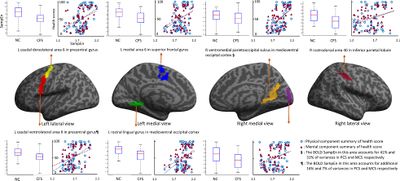Functional magnetic resonance imaging
This article is a stub. |
Functional Magnetic Resonance Imaging (fMRI) is a method of brain magnetic resonance imaging. Unlike in regular magnetic resonance imaging (MRI), which looks at the brain at rest, fMRI is conducted while the patient is performing a cognitive task, in order to identify differences in blood flow related to the cognitive task.

Theory[edit | edit source]
ME/CFS fMRI evidence[edit | edit source]
- 2014, Brains of People With Chronic Fatigue Syndrome Offer Clues About Disorder[2][3][4]
- 2018, Brain function characteristics of chronic fatigue syndrome: A task fMRI study[1]
Cost and availability[edit | edit source]
The University of Michigan, US, current rate for 2018 is $563 per hour.[5]
Specialized training is necessary to operate an fMRI and at this time are rarely used outside of research settings.[6][7] However, it has a "small but growing role in clinical neuroimaging. It is used in pre-surgical planning to localise brain function."[8]
Commercial use[edit | edit source]
Two companies in North America have set up lie detection services and several neuromarketing companies are using fMRI "to gain insights into consumer thought and behaviour."[8]
See also[edit | edit source]
Learn more[edit | edit source]
- How does fMRI brain scanning work? Alan Alda and Dr. Nancy Kanwisher, MIT[10]
- Marketers Should Pay Attention to fMRI[11]
References[edit | edit source]
- ↑ 1.0 1.1 "Brain function characteristics of chronic fatigue syndrome: A task fMRI study". NeuroImage: Clinical. 19: 279–286. January 1, 2018. doi:10.1016/j.nicl.2018.04.025. ISSN 2213-1582.
- ↑ Tuller, David (November 24, 2014), "Brains of People With Chronic Fatigue Syndrome Offer Clues About Disorder", NY Times
- ↑ Zeineh, Michael M; Kang, James; Atlas, Scott W; Raman, Mira M; Reiss, Allan L; Norris, Jane L; Valencia, Ian; Montoya, Jose G (October 29, 2014), "Right Arcuate Fasciculus Abnormality in Chronic Fatigue Syndrome", Radiology, 274 (2): 517–526, doi:10.1148/radiol.14141079
- ↑ Goldman, Bruce (October 28, 2014), "Study finds brain abnormalities in chronic fatigue patients", Stanford Medicine News Center
- ↑ "fMRI: Billing". fmri.research.umich.edu. Retrieved October 12, 2018.
- ↑ Bobholz, Julie A.; Rao, Stephen M.; Saykin, Andrew J.; Pliskin, Neil (2007). "Clinical Use of Functional Magnetic Resonance Imaging: Reflections on the New CPT Codes". Neuropsychology review. 17 (2): 189–191. doi:10.1007/s11065-007-9022-1. ISSN 1040-7308. PMID 17464565.
- ↑ Pressman, Peter (October 1, 2018). "How Does a Functional MRI Machine Work?". Verywell Health. Retrieved October 12, 2018.
- ↑ 8.0 8.1 "How is FMRI Used? — Nuffield Department of Clinical Neurosciences". ndcn.ox.ac.uk. Retrieved October 12, 2018.
- ↑ Herzberg, Mikio (July 30, 2015). "fMRI - How it Works and What it's Good For". YouTube. Mikio Herzberg.
- ↑ Alda, Alan; Kanwisher, Nancy (July 22, 2013). "How does fMRI brain scanning work? Alan Alda and Dr. Nancy Kanwisher, MIT". YouTube. Brains on Trial.
- ↑ Karmarkar, Uma R.; Yoon, Carolyn; Plassmann, Hilke (November 3, 2015). "Marketers Should Pay Attention to fMRI". Harvard Business Review. Retrieved October 12, 2018.

